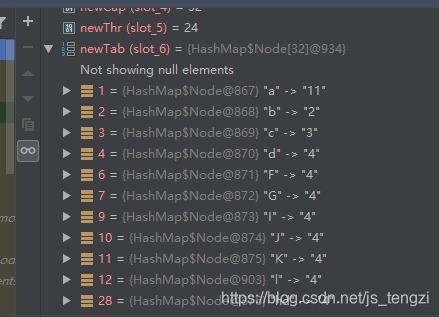前言
上篇文章中我们研究了当HashMap调用put方法,出现“hash冲突”时的处理机制。
我们由此得知,HashMap的内部存储结构分为两个维度,一个维度是横向:
/**
* The table, initialized on first use, and resized as
* necessary. When allocated, length is always a power of two.
* (We also tolerate length zero in some operations to allow
* bootstrapping mechanics that are currently not needed.)
*/
transient Node<K,V>[] table;
由一个个Node<K,V>组成了节点数组。
另一个维度是纵向,我们看下Node<K,V>的结构:
/**
* Basic hash bin node, used for most entries. (See below for
* TreeNode subclass, and in LinkedHashMap for its Entry subclass.)
*/
static class Node<K,V> implements Map.Entry<K,V> {
final int hash;
final K key;
V value;
Node<K,V> next;
Node(int hash, K key, V value, Node<K,V> next) {
this.hash = hash;
this.key = key;
this.value = value;
this.next = next;
}
public final K getKey() { return key; }
public final V getValue() { return value; }
public final String toString() { return key + "=" + value; }
public final int hashCode() {
return Objects.hashCode(key) ^ Objects.hashCode(value);
}
public final V setValue(V newValue) {
V oldValue = value;
value = newValue;
return oldValue;
}
public final boolean equals(Object o) {
if (o == this)
return true;
if (o instanceof Map.Entry) {
Map.Entry<?,?> e = (Map.Entry<?,?>)o;
if (Objects.equals(key, e.getKey()) &&
Objects.equals(value, e.getValue()))
return true;
}
return false;
}
}
从这里我们可以看出Node<K,V>是一个链表结构,用于存储那些key的hash值相等的键值对,按放入的先后顺序组成链表。
正文
这篇文章我们来看看当HashMap出现“hash冲突”时,进行扩容时如何处理链表上的键值对?
测试案例:
@Test
public void test(){
Map<String,Object> map = new HashMap<>();
map.put("a",1);
map.put("a",11);
map.put("b",2);
map.put("c",3);
map.put("d",4);
map.put("Ed",4);
// map.put("E",4);
map.put("F",4);
map.put("G",4);
map.put("hd",4);
// map.put("h",4);
map.put("I",4);
map.put("J",4);
map.put("K",4);
map.put("l",4);
map.put("M",4);
Integer i = (Integer) map.get("a");
System.out.println(i);
}
当执行到map.put(“M”,4)时,此时键值对个数已到达阈值,将进行扩容,即调用resize方法:
/**
* Initializes or doubles table size. If null, allocates in
* accord with initial capacity target held in field threshold.
* Otherwise, because we are using power-of-two expansion, the
* elements from each bin must either stay at same index, or move
* with a power of two offset in the new table.
*
* @return the table
*/
final Node<K,V>[] resize() {
Node<K,V>[] oldTab = table;
int oldCap = (oldTab == null) ? 0 : oldTab.length;
int oldThr = threshold;
int newCap, newThr = 0;
if (oldCap > 0) {
if (oldCap >= MAXIMUM_CAPACITY) {
threshold = Integer.MAX_VALUE;
return oldTab;
}
else if ((newCap = oldCap << 1) < MAXIMUM_CAPACITY &&
oldCap >= DEFAULT_INITIAL_CAPACITY)
newThr = oldThr << 1; // double threshold
}
else if (oldThr > 0) // initial capacity was placed in threshold
newCap = oldThr;
else { // zero initial threshold signifies using defaults
newCap = DEFAULT_INITIAL_CAPACITY;
newThr = (int)(DEFAULT_LOAD_FACTOR * DEFAULT_INITIAL_CAPACITY);
}
if (newThr == 0) {
float ft = (float)newCap * loadFactor;
newThr = (newCap < MAXIMUM_CAPACITY && ft < (float)MAXIMUM_CAPACITY ?
(int)ft : Integer.MAX_VALUE);
}
threshold = newThr;
@SuppressWarnings({"rawtypes","unchecked"})
Node<K,V>[] newTab = (Node<K,V>[])new Node[newCap];
table = newTab;
if (oldTab != null) {
for (int j = 0; j < oldCap; ++j) {
Node<K,V> e;
if ((e = oldTab[j]) != null) {
oldTab[j] = null;
if (e.next == null)
newTab[e.hash & (newCap - 1)] = e;
else if (e instanceof TreeNode)
((TreeNode<K,V>)e).split(this, newTab, j, oldCap);
else { // preserve order
Node<K,V> loHead = null, loTail = null;
Node<K,V> hiHead = null, hiTail = null;
Node<K,V> next;
do {
next = e.next;
if ((e.hash & oldCap) == 0) {
if (loTail == null)
loHead = e;
else
loTail.next = e;
loTail = e;
}
else {
if (hiTail == null)
hiHead = e;
else
hiTail.next = e;
hiTail = e;
}
} while ((e = next) != null);
if (loTail != null) {
loTail.next = null;
newTab[j] = loHead;
}
if (hiTail != null) {
hiTail.next = null;
newTab[j + oldCap] = hiHead;
}
}
}
}
}
return newTab;
}
经过debug测试我们知道,键值对(“hd”,4)与(“l”,4)由于出现“hash冲突”,而被放入Node<K,V>形成了链表结构。
在扩容这一步我们主要关注这一段代码:
for (int j = 0; j < oldCap; ++j) {
Node<K,V> e;
if ((e = oldTab[j]) != null) {
oldTab[j] = null;
if (e.next == null)
newTab[e.hash & (newCap - 1)] = e;
else if (e instanceof TreeNode)
((TreeNode<K,V>)e).split(this, newTab, j, oldCap);
else { // preserve order
Node<K,V> loHead = null, loTail = null;
Node<K,V> hiHead = null, hiTail = null;
Node<K,V> next;
do {
next = e.next;
if ((e.hash & oldCap) == 0) {
if (loTail == null)
loHead = e;
else
loTail.next = e;
loTail = e;
}
else {
if (hiTail == null)
hiHead = e;
else
hiTail.next = e;
hiTail = e;
}
} while ((e = next) != null);
if (loTail != null) {
loTail.next = null;
newTab[j] = loHead;
}
if (hiTail != null) {
hiTail.next = null;
newTab[j + oldCap] = hiHead;
}
}
}
}
当for循环遍历到(“hd”,4)键值对时,HashMap发现这是一个链表结构(next成员属性不为空),而当前节点又不属于TreeNode类型,所以接下来执行以下代码:
Node<K,V> loHead = null, loTail = null;
Node<K,V> hiHead = null, hiTail = null;
Node<K,V> next;
do {
next = e.next;
if ((e.hash & oldCap) == 0) {
if (loTail == null)
loHead = e;
else
loTail.next = e;
loTail = e;
}
else {
if (hiTail == null)
hiHead = e;
else
hiTail.next = e;
hiTail = e;
}
} while ((e = next) != null);
if (loTail != null) {
loTail.next = null;
newTab[j] = loHead;
}
if (hiTail != null) {
hiTail.next = null;
newTab[j + oldCap] = hiHead;
}
我们对这段代码进行分析:
首先,定义了初始值为null的四个节点变量:loHead 、loTail 、hiHead 、hiTail ,以及一个未初始化的节点变量next,
接着进入了一个do-while循环:
do {
next = e.next;
if ((e.hash & oldCap) == 0) {
if (loTail == null)
loHead = e;
else
loTail.next = e;
loTail = e;
}
else {
if (hiTail == null)
hiHead = e;
else
hiTail.next = e;
hiTail = e;
}
} while ((e = next) != null);
此处结合debug调试,得出结果如图:

loHead 、loTail 指向(“l”,4)节点,hiHead 、hiTail指向(“hd”,4)节点.
最后,执行以下代码:
if (loTail != null) {
loTail.next = null;
newTab[j] = loHead;
}
if (hiTail != null) {
hiTail.next = null;
newTab[j + oldCap] = hiHead;
}
结合debug的调试结果如截图:

将loHead 指向的"l",4)节点放入索引为12的位置中,将hiHead指向的(“hd”,4)节点放入索引为28(当前索引12加上原节点数组的长度)的位置中。这里将原有链表结构变成了两个独立的节点,规律有待总结。
以上呈现了当HashMap在扩容时,原有链表结构上的节点是如何处理的过程。










 本文深入探讨HashMap在发生hash冲突并扩容时,如何处理链表上的键值对。通过测试案例和代码分析,展示了扩容过程中节点的重新分布,以及链表变为两个独立部分的过程。
本文深入探讨HashMap在发生hash冲突并扩容时,如何处理链表上的键值对。通过测试案例和代码分析,展示了扩容过程中节点的重新分布,以及链表变为两个独立部分的过程。

















 被折叠的 条评论
为什么被折叠?
被折叠的 条评论
为什么被折叠?








